1. Introduction
Everyone wants
to have a nice smile with beautiful white teeth. However, fluorotic
teeth, (caused by too much fluoride), stained teeth and uneven teeth will
all greatly affect our appearance and social image.According
a research survey from the American Dental Association, 99.7% of adults think a
brilliant smile is an important factor for improving others’ impressions of
you. When asked which factors can most improve a smile, the common answer was
teeth whitening. In the United States, cosmetic dentistry costs occupy as much
as 60% of the average American’s income. Through aesthetic treatments patients
can improve their self-confidence and get a beautiful, white smile.
2. Introduction of different kinds of aesthetic treatments and related cases
Varying according
to different situations and patient requirements, there are numerous ways to do
aesthetic treatments, including: teeth whitening, composite and porcelain
veneers, and various ceramic crowns.
Teeth whitening
Using this
method, different formulations of teeth whitening agents (generally hydrogen peroxide
or urea peroxide) are applied directly on patients’ teeth to whiten teeth
surfaces and eliminate stains. There are two methods for teeth whitening: home-whitening
kits and professional teeth whitening from shanghai dental clinics. Yet both methods,
even the home-whitening method, require a dentist's guidance and supervision.
The advantages of teeth whitening include quick results and low costs, whereas
the drawback is that it only works on teeth that are not overly discolored.
Also, the bleaching process can sometimes cause soreness or allergies. Finally,
teeth whitening is not a permanent solution, and requires repeated treatments
in order to maintain the effect.
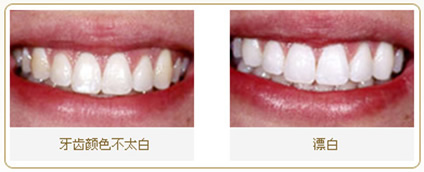
Veneers
Using veneers
is a very popular and widely accepted treatment by patients looking to improve both
the coloration and shape of their teeth. It is quite suitable for patients with
mild to moderate tooth discoloration. Indeed, veneers are especially suitable
for patients with teeth defects, enamel hypoplasia, or mild crowding; or who
have gaps between their teeth; or unsightly tooth shapes, with teeth either too
small or too short. At the moment we have two types of veneer materials: one is
composite and the other is porcelain.
Composite veneers
This refers
to the method of attaching a thin layer of white composite resin on top of the
original tooth surface using dental adhesive. The advantages of this method include
moderate cost and the fact that composite veneers are more effective than teeth
whitening or bleaching. Disadvantages include the need to wear a thin layer of
composite material on the tooth surface permanently and the fact that composite
veneers can sometimes become stained or discolored with age. Finally, the whitening
effect is not quite as white or as beautiful as porcelain veneers or crowns.

Cast porcelain veneers/porcelain crowns
This method
covers the original tooth surface with a layer of cast porcelain to improve the
original color or shape of teeth.Using cast
porcelain results in the best and most beautiful effects among aesthetic
dentistry, but also its costs are among the highest.Porcelain
veneers and crowns both require the original surface of the tooth to be ground
slightly. Veneers require less grinding than crowns, but also the final results
are not as good as crowns. Nevertheless, both porcelain veneers and crowns
result in beautiful, pearly white teeth.
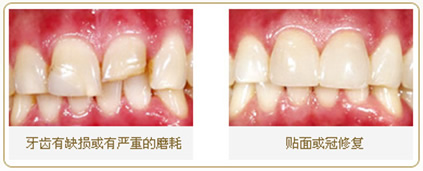
Porcelain Inlay

Porcelain vneer / Porcelain crown
Case A

Case B

Case C
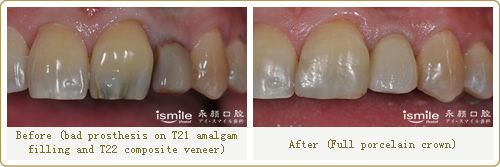
Case D
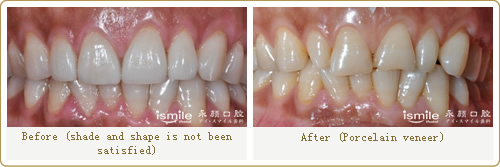
Gum Bleaching
•What is gum bleaching treatment?
Gums can
become stained after years of smoking; often drinking coffee, tea or red wine;
or frequent eating of certain foods with strong pigments that can easily stain
teeth, such as berries. Gum bleaching treatments can help return your stained
gums to their original, healthy pink state.
• What are the procedures for gum bleaching treatments?
We use a special
gum bleaching material (imported from Japan by Dr. Yang) which is applied
directly to the surface of the patients’ gums. Later, the surface layer of the
stained gums will fall off naturally to be replaced by new pink gums.
• Is there any pain during the gum bleaching treatment?
There is
almost no pain and discomfort throughout the entire course of a gum bleaching
treatment. And if the patient pays attention to their oral hygiene with daily
cleanings, the good effect can be maintained for two years.
• Which kinds of patients are suitable for gum bleaching treatments?
Anyone who
has stained or blackened gums caused by long-term smoking, or by drinking coffee
or tea frequently are suitable candidates for gum bleaching. Also, patients who
have just received teeth whitening may choose to receive a gum bleaching
treatment to help them have pink gums to match their newly whitened teeth.
• Success Stories
Case A:
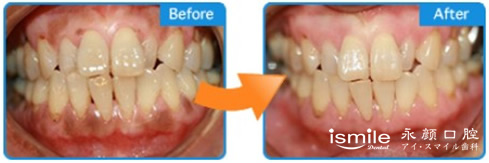
Case B:
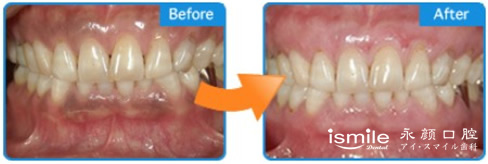
Case C:
As you can
see, this patient had more serious symptoms, and so was required to do two
courses of the treatment. (Results are shown below.)
Note: For
patients with serious staining, our dentists suggest separating the treatment into
two visits, once for the upper gums and once for the lower gums.

|
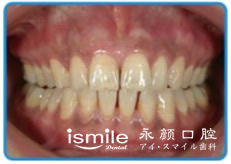
|
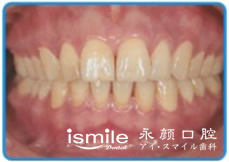
|
|
Before
|
After first treatment
|
Final result
|
3. Frequently Asked Questions
1)Is there any pain when undergoing aesthetic treating?
Patients may
feel some sensitivity or soreness during a teeth whitening treatment, and oral
pain medication is sometimes necessary. A thin layer of the tooth’s surface
needs to be ground when receiving veneers or crowns,and
anesthetics are always given as the teeth preparation and crowns or veneers are
applied to prevent any sensitivity. However, this kind of minor discomfort can
be easily tolerated by most people.
2)Are there any risks for bad results?
With high
quality veneers or crowns, there is rarely any risk, especially if the patient
has good oral hygiene and good teeth cleaning habits.Some
of the factors that can affect a failed prosthetic treatment include:
The patient did not undergo a
periodontal treatment before receiving their prosthesis.
The dentist is not highly skilled
enough.
The patient does not continue to
perform regular oral hygiene properly.
In the rare
case of a failure, the result will not only cause the patient to lose money,
but could also damage the health of their teeth.
A perfect
prosthesis
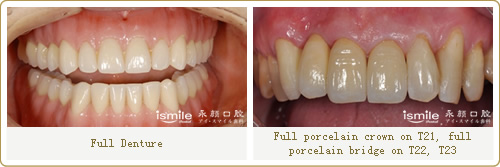
This prosthesis
will not irritate the patient’s gums, and the gums look very healthy.

A bad
prosthesis

A bad
prosthesis may cause swollen gums and inflammation, with adverse effects ranging
from the need to remove the bad prosthesis to the need to extract the entire
tooth.

3)Is Aesthetic Dentistry Helpful to Tooth Health?
Aesthetic dentistry will not destroy the tooth health if the doctor has
professional skills and the patients can care for their teeth well. There will
be some allergy symptoms when tooth bleaching. Generally, such symptoms are
reversible.
To do the veneer or all ceramic crown needs to remove 0.6-1.5mm dental
tissues, but will not affect the strength of your teeth. Generally, your dental
nerve will not be affected. Although there will be some allergy symptoms, they
can recover.
Cosmetic dental patients should remember: choose regular and professional
cosmetic dentistry team; ensure your gum is healthy and you have cleaned your
teeth before cosmetic dentistry; periodontal patients can do cosmetic dentistry
only after treatment to ensure stability of disease; must do care and cleaning
work well after the cosmetic dentistry; do professional oral examination and
teeth cleaning every 6 months.
4)What Are the Differences Between Metal Porcelain Teeth and Porcelain Teeth
The biggest difference between porcelain teeth and metal porcelain teeth is
the materials of the inner crown. The material of porcelain teeth is porcelain,
without any metal actually, while there is a layer of metal in the metal
porcelain teeth. In comparison with porcelain teeth, the MPT will have black
lines on crown edge of and it has a lower transparency. What’s more, if the
bio-compatibility of the metal is not good, it will do side effects to your gum.
Your gun will become dyed or dark when the metal is oxidized.
The only material used to make porcelain teeth is porcelain, which has high
bio-compatibility and will not do harm to your gum to cause gum inflammation and
gum discoloration. So, there is no doubt that is the best choice for people who
have higher requirements for cosmetic dentistry. What’s more, the porcelain
teeth have good transparency and high bio-compatibility and have no oxidation
problems.


